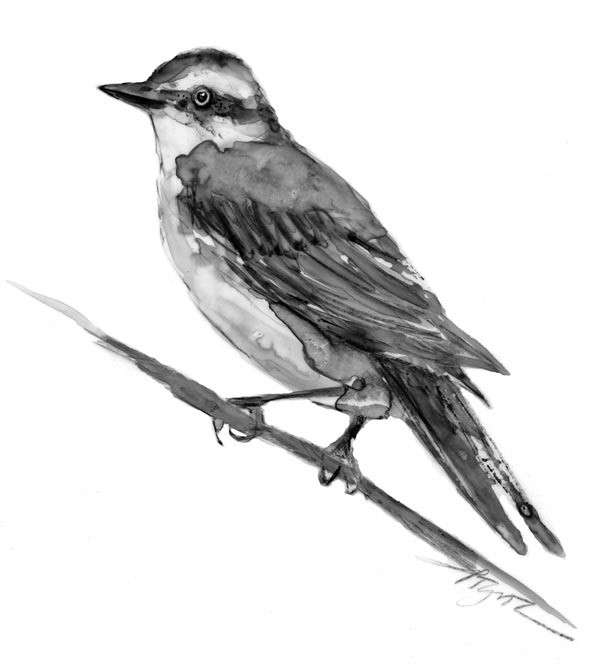
Among the noisy throngs of blackbirds that are the earliest harbingers of spring in the Northeast, the rusty blackbird often escapes notice. Few birders encounter this enigmatic songbird during the course of spring migration, and because rusties rarely join the conspicuous flocks of red-winged blackbirds and common grackles that descend on our feeding stations from mid-March onwards, few come to know the bird well. This uncommon, reclusive denizen of wooded wetlands and shrubby swamps is most commonly found by venturing off the beaten track.
The rusty blackbird is a transient that appears only briefly on its way to and from breeding grounds that extend across the boreal zone of northern New England, New York, Canada, and Alaska. The most northerly-breeding of North America’s blackbirds, rusties are almost invariably associated with water, nesting along the edges of bogs, alder-willow swamps, beaver ponds, and other forest openings. During their early spring and late fall migrations, rusties are sometimes found foraging in open areas such as pasture, stubble, plowed fields, and swamp edges. A lucky observer in spring may hear the males’ peculiar, gurgling song, which is anything but melodic.
Wintering birds are concentrated in the southeastern U.S., where they frequent wet woodlands and only occasionally consort with other blackbirds. Year-round, the species’ diet consists primarily of animal prey, in the form of aquatic invertebrates and small fish.
The remote habitats, low population densities, and inconspicuous behavior of rusty blackbirds have caused the species to languish in relative obscurity. Few detailed studies of its ecology and life history exist, and populations are not well tracked by continent-wide monitoring programs such as the Breeding Bird Survey (BBS) or Christmas Bird Count (CBC). Sightings of this already uncommon species have, in the past 3-4 decades, become even less common, and analysis of existing BBS and CBC data tell the same tale. Some estimates suggest that the species’ populations have plummeted by as much as 95 percent since the early 1970s, with birds virtually disappearing from a number of boreal Canadian areas where they had once commonly nested.
Scientists are both puzzled and troubled by such rapid declines in a species that generally has little contact with humans. Widespread concerns have spawned a surge in research and formation of the Rusty Blackbird Technical Working Group to understand and address the species’ population freefall. Early indications are that the unique natural history of rusty blackbirds places the bird at special risk to human-induced changes in its environment. As North America’s most ecologically specialized blackbird, rusties may be unable to adapt quickly enough to these changes.
Leading hypotheses for the steep declines include winter habitat loss due to conversion of bottomland hardwood forests to agriculture in the southeastern United States, loss and degradation of boreal wetland breeding habitats from development (such as peat production, logging, reservoir creation) or acidification, mercury bioaccumulation (to which rusties are predisposed via their aquatic animal-based diet), and direct and indirect effects of climate change. This latter threat is suspected to be causing changes in the extent of boreal wetlands, their chemistry and hydrology, and the structure of their invertebrate communities.
Additional, as-yet-unsubstantiated causes of decline in rusty blackbirds may include winter mortality during blackbird control programs in the 1960s and 1970s, inherently low immunity to diseases picked up by joining large winter roosts of mixed blackbird species, and increased competition with other blackbirds as winter habitat loss has caused rusties to feed in more open habitats with grackles and red-wings. Explanations for the plight of rusty blackbirds are elusive, complicated, and convoluted, probably involving an interplay of all these factors, and perhaps others.
Closer to home, recent studies in New England suggest that timber management practices affect rusty blackbird nest survival. In Vermont and Maine, nests in regenerating clearcuts less than 20 years old were more than twice as likely to be taken by predators than nests in more mature forest. Researchers believe that un-logged, 250-foot buffers around suitable wooded wetlands would reduce nest depredation, but other silvicultural practices might also be effective. In northern New England and elsewhere, maintenance of quality breeding habitat is of vital importance until the factors affecting rusty blackbird population viability across its life cycle are more fully understood.
For any organism, conservation efforts are most effective when initiated while the species is still common. However, it is impossible to develop a meaningful conservation strategy when the causes of decline are so poorly documented. We have much to learn in the case of the rusty blackbird, and we would do well to abide by the precautionary principle. The spring flight is winding down, but get outside soon, or next October and November, to listen for the gurgling song and squeaky whistled calls of this uncommon blackbird with pale yellow eyes.

